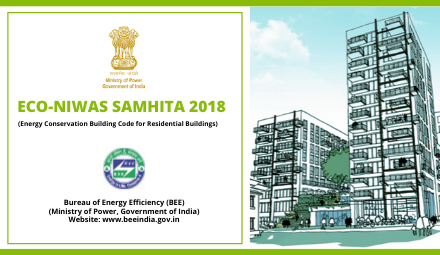
- Posted On: July 21, 2021
In the previous blog, we explored how important it is for the housing market to embrace comfort and energy standards. With this in mind, the government launched the residential building energy code – Eco Niwas Samhita (Part 1: Building Envelope) in 2018 as an important regulatory measure for improving thermal comfort and energy use in housing.
Let’s now address some of the commonly asked questions about this building Code to better understand its need and application for the Indian building sector.
What is the need for an energy code?
Similar to other codes for fire and structural safety, Eco Niwas Samhita (ENS) specifies the minimum requirements that residential buildings should be designed for, to ensure comfortable temperatures can be maintained inside houses for longer, reducing the need for active cooling and heating and also the energy required for it.
Even with knowledge of passive design measures and climate appropriate design practices within the design industry, it is difficult to ensure that all housing projects are built to a minimum standard without using a Code which can be used to assess compliance. This is evident as current green housing projects in the country look to adopt voluntary rating systems such as Leadership in Energy and Environmental Design (LEED), Green Rating for Integrated Habitat Assessment (GRIHA) etc., but their use is preferred by high-income housing projects where both users and developers understand the benefits and represent the first movers in the market.
However, the bulk of the housing market needs guidance from a standard approach like a Code to lead to large scale adoption and availability of energy efficient houses. This ensures basic minimum criteria is met across housing projects, allows for ease of compliance by the government and is not limited to an individual designer’s skill, eventually, leading to informed practices being adopted by the larger housing industry.
Aren’t Code compliant buildings expensive to build?
Depending on the design approach and materials used, the additional costs for complying with the Eco-Niwas Samhita are likely to minimal and in the range of 1-2% of the total cost of the building. It has been designed to be used by mass housing projects by using construction materials and technologies that are affordable and readily available in the market.
What are the ENS compliance requirements?
Eco-Niwas Samhita has been designed after studying energy use in hundreds of apartments in different cities across climate zones in India. This data has been used to simulate multiple combinations of possible solutions to arrive at the optimal standard for different climate types based on common construction practices.
The Code provides design flexibility to innovate in the design of building envelope, passive measures and choice of building materials to meet the compliance requirements.
To check compliance, architects and designers will need to fill in readily available information from architectural drawings about building areas, construction materials for the envelope, orientation and location in India into a compliance tool. This does not require any simulation software to be used.
-
- Smita Chandiwala






